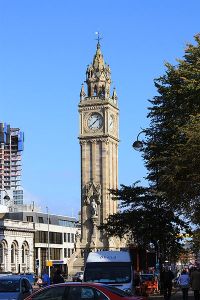Albert Memorial Clock
 While in Belfast on your Titanic Experience
While in Belfast on your Titanic Experience day tour from Dublin check out the Albert Memorial Clock situated at Queen’s Square
in Belfast, Northern Ireland. This leaning
clock tower was completed in 1869 and is
one of the best known landmarks of Belfast.
In 1865 a competition for the design of a memorial to Queen Victoria’s late Prince Consort, Prince Albert, was won by
W. J. Barre, who had earlier designed
Belfast’s Ulster Hall. Initially Barre was
not awarded his prize and the contract
was secretly given to Lanyon, Lynn,
and Lanyon, who had come second.
Following public outcry the contract
was eventually awarded to Barre. The construction cost of £2,500
(2011: £181,000) was raised by public subscription.
Being situated close to the docks, the tower was once infamous for being
frequented by prostitutes plying their trade with visiting sailors. However,
in recent years regeneration has turned the surrounding Queen’s Square and
Custom’s House Square into attractive, modern public spaces with trees,
fountains and sculptures.
frequented by prostitutes plying their trade with visiting sailors. However,
in recent years regeneration has turned the surrounding Queen’s Square and
Custom’s House Square into attractive, modern public spaces with trees,
fountains and sculptures.
The sandstone memorial was constructed between 1865 and 1869 by
Fitzpatrick Brothers builders and stands 113 feet tall in a mix of French
and Italian Gothic styles. The base of the tower features flying buttresses
with heraldic lions.
A statue of the Prince in the robes of a Knight of the Garter stands on the
western side of the tower and was sculpted by SF Lynn. A two tonne bell is
housed in the tower and the clock was made by Francis Moore of High
Street, Belfast.
Fitzpatrick Brothers builders and stands 113 feet tall in a mix of French
and Italian Gothic styles. The base of the tower features flying buttresses
with heraldic lions.
A statue of the Prince in the robes of a Knight of the Garter stands on the
western side of the tower and was sculpted by SF Lynn. A two tonne bell is
housed in the tower and the clock was made by Francis Moore of High
Street, Belfast.
As a result of being built on wooden piles on marshy, reclaimed land
around the River Farset, the top of the tower leans four feet off the
perpendicular. Due to this movement, some ornamental work on the belfry
was removed in 1924 along with a stone canopy over the statue of the Prince.
around the River Farset, the top of the tower leans four feet off the
perpendicular. Due to this movement, some ornamental work on the belfry
was removed in 1924 along with a stone canopy over the statue of the Prince.
In 1947, the film Odd Man Out was filmed partly in Belfast, with the Albert
Clock as a central location, although neither the town nor the clock is explicitly identified.
Clock as a central location, although neither the town nor the clock is explicitly identified.
No comments:
Post a Comment